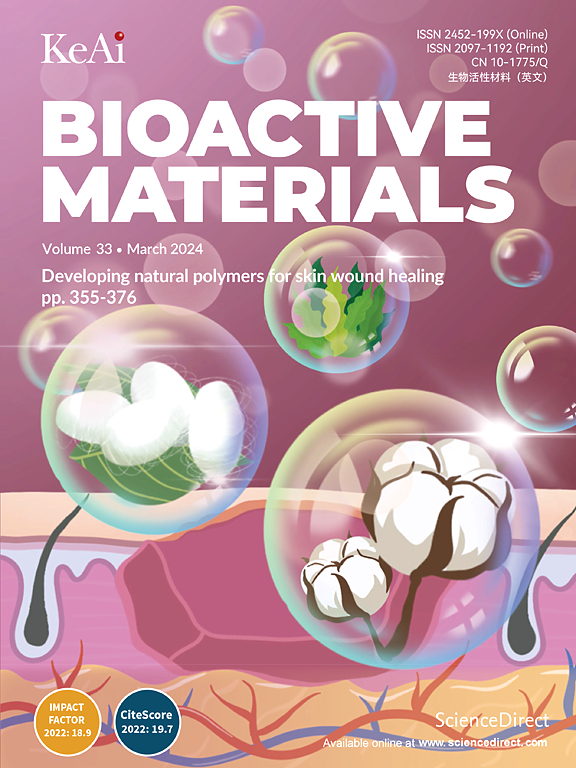Reprogramming of iPSCs to NPCEC-like cells by biomimetic scaffolds for zonular fiber reconstruction
IF 18
1区 医学
Q1 ENGINEERING, BIOMEDICAL
引用次数: 0
Abstract
Ectopia lentis (EL), characterised by impaired zonular fibers originating from non-pigmented ciliary epithelial cells (NPCEC), presents formidable surgical complexities and potential risks of visual impairment. Cataract surgery is the only treatment method for EL, but it leads to the loss of accommodative power of the lens post-operatively. Furthermore, the challenge of repairing zonular ligaments in situ remains a significant global issue. Ocular tissue and aqueous humour samples from patients with EL were subjected to RNA sequencing and Olink high-throughput proteomic analysis, revealing the downregulation of pathogenic genes (FBN1, MFAP2) and upregulation of secretory proteins (IL-12, MMP-1). The high expression of FBN1 and MFAP2 in NPCECs suggests their potential as candidates for zonular fiber construction; however, the limited availability of donor sources restricts the feasibility of NPCEC transplantation therapy. The reprogramming and directional differentiation of induced pluripotent stem cells (iPSC) to NPCEC was successfully achieved using the developed biomimetic scaffolds that mimic the microstructures of natural radial zonular fibers. Excitingly, the single injection of induced NPCEC-like cells significantly contributed to restoring and enhancing mechanical properties in zonular fiber structures in a rabbit model with EL. This proposed in situ iPSC-based regeneration technique might serve as an innovative therapeutic strategy for clinical EL patients, reduce the cataract surgery rate, and retain the adjustment capacity of inherent lentis.

利用仿生支架将iPSCs重编程为npcec样细胞用于带状纤维重建。
晶状体异位(EL)以源自非色素睫状体上皮细胞(NPCEC)的带状纤维受损为特征,其手术复杂性和潜在的视力损害风险令人生畏。白内障手术是EL的唯一治疗方法,但术后会导致晶状体调节能力丧失。此外,原位修复带状韧带的挑战仍然是一个重大的全球性问题。对EL患者眼组织和体液样本进行RNA测序和Olink高通量蛋白质组学分析,发现致病性基因(FBN1、MFAP2)下调,分泌蛋白(IL-12、MMP-1)上调。FBN1和MFAP2在NPCECs中的高表达表明它们可能是带状纤维构建的候选者;然而,有限的供体来源限制了NPCEC移植治疗的可行性。利用模拟天然径向带状纤维微结构的仿生支架,成功实现了诱导多能干细胞(iPSC)向NPCEC的重编程和定向分化。令人兴奋的是,单次注射诱导的npcec样细胞明显有助于恢复和增强家兔EL模型的带状纤维结构的力学性能。本研究提出的基于ipsc的原位再生技术可以作为临床EL患者的创新治疗策略,降低白内障手术率,并保留固有晶状体的调节能力。
本文章由计算机程序翻译,如有差异,请以英文原文为准。
求助全文
约1分钟内获得全文
求助全文
来源期刊

Bioactive Materials
Biochemistry, Genetics and Molecular Biology-Biotechnology
CiteScore
28.00
自引率
6.30%
发文量
436
审稿时长
20 days
期刊介绍:
Bioactive Materials is a peer-reviewed research publication that focuses on advancements in bioactive materials. The journal accepts research papers, reviews, and rapid communications in the field of next-generation biomaterials that interact with cells, tissues, and organs in various living organisms.
The primary goal of Bioactive Materials is to promote the science and engineering of biomaterials that exhibit adaptiveness to the biological environment. These materials are specifically designed to stimulate or direct appropriate cell and tissue responses or regulate interactions with microorganisms.
The journal covers a wide range of bioactive materials, including those that are engineered or designed in terms of their physical form (e.g. particulate, fiber), topology (e.g. porosity, surface roughness), or dimensions (ranging from macro to nano-scales). Contributions are sought from the following categories of bioactive materials:
Bioactive metals and alloys
Bioactive inorganics: ceramics, glasses, and carbon-based materials
Bioactive polymers and gels
Bioactive materials derived from natural sources
Bioactive composites
These materials find applications in human and veterinary medicine, such as implants, tissue engineering scaffolds, cell/drug/gene carriers, as well as imaging and sensing devices.
 求助内容:
求助内容: 应助结果提醒方式:
应助结果提醒方式:


